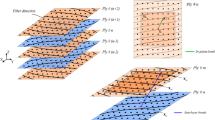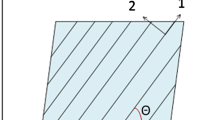Abstract
Damage growth in composites involves complex and progressive failure modes. Current computational tools are incapable of predicting failure in composite materials in a unified manner mainly due to their mathematical structure. However, the peridynamic (PD) theory removes these obstacles by taking into account nonlocal interactions between material points. The PD theory simply replaces the displacement derivatives in the equilibrium equations. The PD enables the modeling of progressive failure during deformation through the removal of nonlocal PD interactions (bonds). These bonds enable the interaction of material points within each ply as well as their interaction with other material points in the adjacent plies. The solution continues by using standard explicit time integration techniques until final failure. This chapter presents PD modeling approaches namely bond-based, ordinary state-based, and PD differential operator for predicting progressive damage in fiber-reinforced composite materials under general loading conditions. The predictions from the PD models agree with the experimental observations published in the literature.
Access this chapter
Tax calculation will be finalised at checkout
Purchases are for personal use only
Similar content being viewed by others
References
Krueger R (2004) Virtual crack closure technique: history, approach, and applications. Appl Mech Rev 57:109–143
Liu PF, Hou SJ, Chu JK, Hu XY, Zhou CL, Liu YL, Zheng JY, Zhao A, Yan L (2011) Finite element analysis of postbuckling and delamination of composite laminates using virtual crack closure technique. Compos Struct 93:1549–1560
Shokrieh MM, Rajabpour-Shirazi H, Heidari-Rarani M, Haghpanahi M (2012) Simulation of mode I delamination propagation in multidirectional composites with R-curve effects using VCCT method. Comput Mater Sci 65:66–73
Borg R, Nilsson L, Simonsson K (2001) Simulation of delamination in fiber composites with a discrete cohesive failure model. Compos Sci Tech 61:667–677
Yang Q, Cox B (2005) Cohesive models for damage evolution in laminated composites. Int J Fract 133:107–137
Zhao L, Gong Y, Zhang J, Chen Y, Fei B (2014) Simulation of delamination growth in multidirectional laminates under mode I and mixed mode I/II loadings using cohesive elements. Compos Struct 116:509–522
Rybicki EF, Kanninen MF (1977) A finite element calculation of stress intensity factors by a modified crack closure integral. Eng Fract Mech 9:931–938
Dugdale DS (1960) Yielding of steel sheets containing slits. J Mech Phys Solids 8:100–104
Barenblatt GI (1962) The mathematical theory of equilibrium cracks in brittle fracture. Adv Appl Mech 7:55–129
Belytschko T, Black T (1999) Elastic crack growth in finite elements with minimal remeshing. Int J Numer Method Eng 45:601–620
Moes N, Dolbow J, Belytschko T (1999) A finite element method for crack growth without remeshing. Int J Numer Method Eng 46:131–150
Silling S (2000) Reformulation of elasticity theory for discontinuities and long-range forces. J Mech Phys Solids 48:175–209
Silling S, Epton M, Weckner O, Xu J, Askari E (2007) Peridynamic states and constitutive modeling. J Elast 88:151–184
Madenci E, Oterkus E (2014) Peridynamic theory and its applications. Springer
Madenci E, Dorduncu M, Phan N, Gu X (2019) Weak form of bond-associated non-ordinary state-based peridynamics free of zero energy modes with uniform or non-uniform discretization. Eng Fract Mech 218:106613
Madenci E, Dorduncu M, Barut A, Phan N (2018) A state-based peridynamic analysis in a finite element framework. Eng Fract Mech 195:104–128
Askari E, Xu J, Silling S (2006) Peridynamic analysis of damage and failure in composites. In: 44th AIAA/ASME/ASCE/AHS/ASC aerospace sciences meeting and exhibit, Reno, NV. AIAA 2006-88
Xu J, Askari A, Weckner O, Razi H, Silling S (2007) Damage and failure analysis of composite laminates under biaxial loads. 48th AIAA/ASME/ASCE/AHS/ASC structures, structural dynamics, and materials conference, Honolulu, HI. AIAA 2007–2315
Xu J, Askari A, Weckner O, Silling S (2008) Peridynamic analysis of impact damage in composite laminates. J Aerospace Eng 21:187–194
Kilic B, Agwai A, Madenci E (2009) Peridynamic theory for progressive damage prediction in center-cracked composite laminates. Compos Struct 90:141–151
Oterkus E, Madenci E (2012) Peridynamic analysis of fiber-reinforced composite materials. J Mech Mater Struct 7:45–84
Hu W, Ha YD, Bobaru F (2011) Modeling dynamic fracture and damage in a fiber-reinforced composite lamina with peridynamics. Int J Multiscale Comput Eng 9:707–726
Oterkus E, Madenci E, Weckner O, Silling S, Bogert P, Tessler A (2012) Combined finite element and peridynamic analyses for predicting failure in a stiffened composite curved panel with a central slot. Compos Struct 94:839–850
Ghajari M, Iannucci L, Curtis P (2014) A peridynamic material model for the analysis of dynamic crack propagation in orthotropic media. Comput Method Appl Mech Eng 276:431–452
Hu YL, Yu Y, Wang H (2014) Peridynamic analytical method for progressive damage in notched composite laminates. Compos Struct 108:801–810
Hu YL, Madenci E (2016) Bond-based peridynamic modeling of composite laminates with arbitrary fiber orientation and stacking sequence. Compos Struct 153:139–175
Diyaroglu C, Oterkus E, Madenci E, Rabczuk T, Siddiq A (2016) Peridynamic modeling of composite laminates under explosive loading. Compos Struct 144:14–23
Sadowski T, Pankowski B (2016) Peridynamical modelling of nanoindentation in ceramic composites. Solid State Phenom 254:55–59
Ren B, Wu CT, Seleson P, Zeng D, Lyu D (2018) A peridynamic failure analysis of fiber-reinforced composite laminates using finite element discontinuous Galerkin approximations. Int J Fract 214:49–68
Diana V, Casolo S (2019) A full orthotropic micropolar peridynamic formulation for linearly elastic solids. Int J Mech Sci 160:140–155
Colavito KW, Barut A, Madenci E, Phan N (2013) Residual strength of composite laminates with a hole by using peridynamic theory. 54th AIAA/ASME/ASCE/AHS/ASC structures, structural dynamics and materials conference, Boston, MA, AIAA-2013-1761
Jiang XW, Wang H (2018) Ordinary state-based peridynamics for open-hole tensile Strength prediction of fiber-reinforced composite laminates. J Mech Mater Struct 13:53–82
Jiang XW, Wang H, Shijun G (2019) Peridynamic open-hole tensile strength prediction of fiber-reinforced composite laminate using energy-based failure criteria. Adv Mater Sci Eng 2019:7694081
Zhang H, Qiao P (2019) A state-based peridynamic model for quantitative elastic and fracture analysis of orthotropic materials. Eng Fract Mech 206:147–171
Gao Y, Oterkus S (2019) Fully coupled thermomechanical analysis of laminated composites by using ordinary state based peridynamic theory. Compos Struct 207:397–424
Rädel M, Willberg C, Krause D (2019) Peridynamic analysis of fibre-matrix debond and matrix failure mechanisms in composites under transverse tensile load by an energy-based damage criterion. Compos. Part B 158:18–27
Hattori G, Trevelyan J, Coombs WM (2018) A non-ordinary state-based peridynamics framework for anisotropic materials. Comput Method Appl Mech Eng 339:416–442
Yaghoobi A, Chorzepa MG (2015) Meshless modeling framework for fiber reinforced concrete structures. Comput Struct 161:43–54
Shang S, Qin X, Li H, Cao X (2019) An application of non-ordinary state-based peridynamics theory in cutting process modelling of unidirectional carbon fiber reinforced polymer material. Compos Struct 226:111194
Madenci E, Dorduncu M, Phan N (2018) Peridynamics for progressive failure analysis of composites. 33rd technical conference of the American society for composites, 599–613
Silling S, Askari E (2005) A meshfree method based on the peridynamic model of solid mechanics. Comput Struct 83:1526–1535
Colavito KW (2013) Peridynamics for failure and residual strength prediction of fiber-reinforced composites. PhD Thesis, University of Arizona
Satyanarayana A, Bogert PA, Chunchu PB (2007) The effect of delamination on damage path and failure load prediction for notched composite laminates. 48th AIAA/ASME/ASCE/AHS/ASC structures, structural dynamics, and materials conference, Honolulu, HI. AIAA 2007-1993
Colavito KW, Kilic B, Celik E, Madenci E, Askari E, Silling S (2007) Effects of nanoparticles on stiffness and impact strength of composites. 48th AIAA/ASME/ASCE/AHS/ASC structures, structural dynamics, and materials conference, Honolulu, HI. AIAA 2007-2021
Colavito KW, Kilic B, Celik E, Madenci E, Askari E, Silling S (2007) Effect of void content on stiffness and strength of composites by a peridynamic analysis and static indentation test. 48th AIAA/ASME/ASCE/AHS/ASC structures, structural dynamics, and materials conference, Honolulu, HI. AIAA 2007-2257
Madenci E, Barut A, Futch M (2016) Peridynamic differential operator and its applications. Comput Method Appl Mech Eng 304:408–451
Author information
Authors and Affiliations
Corresponding author
Editor information
Editors and Affiliations
Rights and permissions
Copyright information
© 2021 The Author(s), under exclusive license to Springer Nature Switzerland AG
About this chapter
Cite this chapter
Madenci, E., Dorduncu, M. (2021). Peridynamic Modeling of Laminated Composites. In: Ghavanloo, E., Fazelzadeh, S.A., Marotti de Sciarra, F. (eds) Size-Dependent Continuum Mechanics Approaches. Springer Tracts in Mechanical Engineering. Springer, Cham. https://doi.org/10.1007/978-3-030-63050-8_13
Download citation
DOI: https://doi.org/10.1007/978-3-030-63050-8_13
Published:
Publisher Name: Springer, Cham
Print ISBN: 978-3-030-63049-2
Online ISBN: 978-3-030-63050-8
eBook Packages: EngineeringEngineering (R0)




